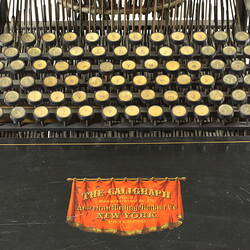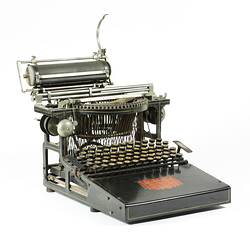Summary
Typewriter of the type-bar class invented by G. W. N. Yost and manufactured by the American Writing Machine Company of New York, USA. The Caligraph was the first machine to use a full keyboard, with each uppercase and lowercase letter, and each number and sign having a separate key.
This machine is of the up-stroke type, in which the type-bar moves upward to strike the paper on the underside of the platen. The letters being typed are thus not visible to the typist.
Physical Description
Black-finished metal frame with gold lining. Type bars arranged in circular "basket" formation at rear of frame. Faceted platen on carriage above basket. Ribbon carried between spools on horizontal axes. Full keyboard with separate key for each character in front of basket. Sloping metal plate in front of keyboard. Included is a shaped wooden cover which fits over the typewriter.
More Information
-
Collecting Areas
-
Acquisition Information
Donation from The Argus, 11 Jul 1922
-
Inventor
Mr G. W.N. Yost, New York, New York State, United States of America, 1880
-
Manufacturer
American Writing Machine Co, New York, New York State, United States of America, circa 1890
-
User
The Argus and Australasian Ltd., Melbourne, Greater Melbourne, Victoria, Australia, circa 1890-1920
-
Inscriptions
Decal on sloping metal plate in front of keyboard, with words: "THE CALIGRAPH / No. 2 / Manufactured by / American Writing Machine Co. / NEW YORK / PATENTED"
-
Classification
-
Category
-
Discipline
-
Type of item
-
Overall Dimensions
375 mm (Width), 405 mm (Depth), 300 mm (Height)
-
Maximum dimensions
440 mm (Length), 360 mm (Width), 290 mm (Height)
Measurement From Conservation.
-
Keywords
Office Equipment, Stationery, Typewriters, Writing Equipment



